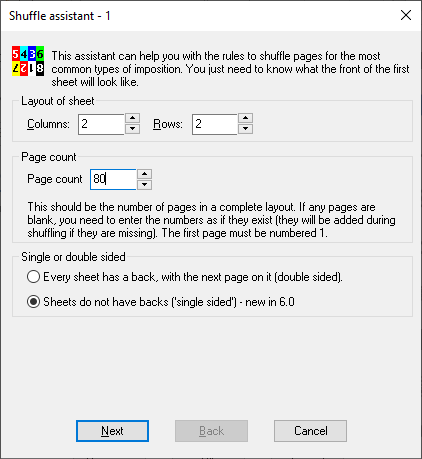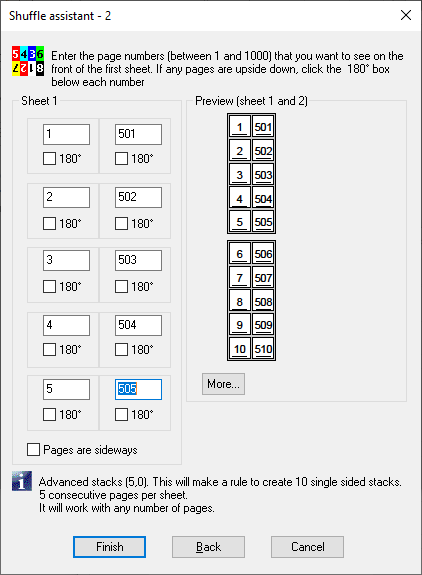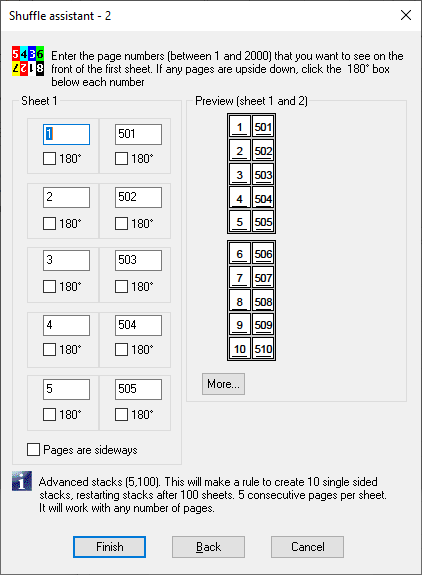Shuffle and Shuffle Assistant were enanced in several ways for version 6.0.
· Shuffle assistant previously only worked for double sided. Now there is an option for single sided.
· Shuffle assistant now allows up to 20 x 20 grid (max 100 pages)
· Shuffle assistant gives feedback on the type of shuffle that will be generated. This appears below the space where you enter page numbers. This lets you check whether the layout matches your expectations.
· Advanced stacks (including in assistant).
Shuffle Assistant – single sided option (6.0)
Version 6.0 supports a choice of “double sided” or “single sided”.

The difference between them is that, when choosing double sided, the back sheet will automatically contain the sheet matching the front of the sheet, but mirrored from right to left. Single sided can be used for simple runs of pages, or for single sided cut stacks. It cannot be used for groups of pages in multiple bindings (“perfect bound”).
Advanced cut stacks (6.0)
Cut stacks are used for many purposes. Not just regular books, but stacks of adverts or books of tickets for example. Version 6.0 adds additional types of stack, which meet special requirements.
· Consecutive pages per group (A).
· Start stacks again after a maximum number of groups (B)
This information is often shown in a compact form as “Advanced stacks (A,B)”. B is zero if the stacks never need to start again. We illustrate this using the shuffle assistant, but a shuffle of this type can also be entered without using the assistant.
Two examples of consecutive pages per group is seen here. They are single sided (no backs). In this example a
page count of 1000 is specified.
This might be used to print a book
of numbered tickets. In the example below, the printed sheets will be cut once,
top to bottom, to make two booklets of 100 sheets, each with five tickets.
Page count = 1000
Notice that in the example above,
the “start stacks again after groups” is zero i.e. the zero in “Advanced stacks
(5,0)”. This means that the rule will adapt to any number of pages. For
example, if it is run with 1600 pages, it will make stacks of 160 sheets.
Now we take an example where the
page count is larger – 2000 can be chosen but any number which is a multiple of
the pages per sheet and larger than 1000 will do. 
Page count = 2000
The page numbers typed in the
assistant are impossible for a 2000 page layout done as normal stacks. In a
2000 page layout the numbers would need to be 1001-1005 rather than 501-505. So
the software knows the stacks must have limited depth. Notice it reads
“Advanced stacks (5,100)” – so it is repeated after 100 groups. Since it is
single sided, the group is one sheet, and the 100 groups hold 1000
tickets/pages. This layout would be
printed, then divided up into exactly 100 sheet stacks. Each stack would then
be split vertically, and would yield two booklets.
This layout is also adaptable to
any number of pages, but it will always break up into the specified number of
sheets, finishing with fewer sheets if needed. To emphasise, in Shuffle
Assistant, the decision of which type to use is based on the page count.
Repeating after groups can also be
used without repeating counts, to create stacks of limited depth.